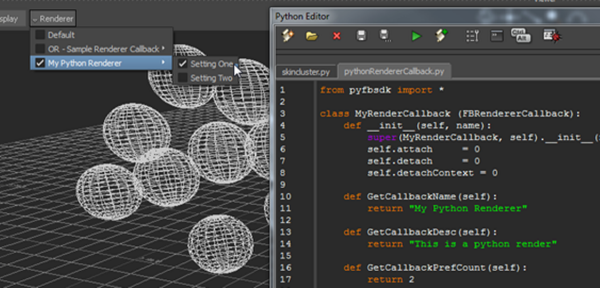Using Python to Implement a Custom Renderer
The following Python script demonstrates how you can use Python to implement a custom renderer:
from pyfbsdk import *
class MyRenderCallback (FBRendererCallback):
def __init__(self, name):
super(MyRenderCallback, self).__init__(name)
def GetCallbackName(self):
return "My Python Renderer"
def GetCallbackDesc(self):
return "This is a python render"
def GetCallbackPrefCount(self):
return 2
def GetCallbackPrefName(self, pIndex):
if pIndex == 0:
return "Setting One"
else:
return "Setting Two"
def Attach(self):
pass
def Detach(self):
pass
def DetachDisplayContext(self, options):
pass
def Render(self, options):
lRender = FBSystem().Renderer
lCount = lRender.DisplayableGeometryCount - 1
while(lCount >= 0) :
lModel = lRender.GetDisplayableGeometry(lCount)
lRender.OGLModelDisplay(options, lModel)
lCount = lCount - 1
# Create python renderer
lMyRender = MyRenderCallback("My Python Renderer")
# Register this custom render to system
FBSystem().Renderer.RendererCallbacks.append(lMyRender)
# Turn it on
FBSystem().Renderer.CurrentPaneCallbackIndex = len (FBSystem().Renderer.RendererCallbacks) - 1
# Unregister and delete the python renderer
'''
if(len(FBSystem().Renderer.RendererCallbacks)):
lMyRender = FBSystem().Renderer.RendererCallbacks.pop()
lMyRender.FBDelete()
'''Although, this script looks trivial from a production perspective at first, but it actually indicates how to achieve greater flexibility. You can choose to use the PyOpenGL Python package to implement a more useful rendering. You can also implement the performance demanding routines in C++ first and then expose them in Python. You can eventually use them inside this Python based custom renderer. In this way, the flexibility of Python and efficiency of C++ can be utilized. The following figure shows the Python implementation of the custom renderer.

